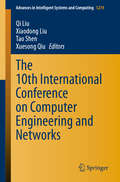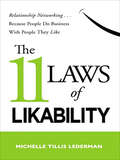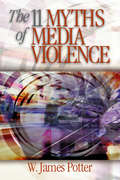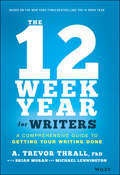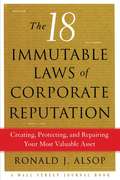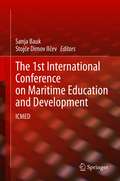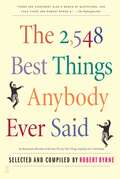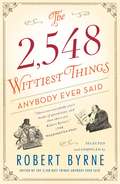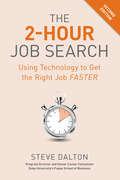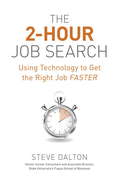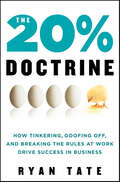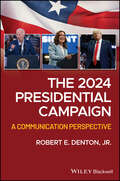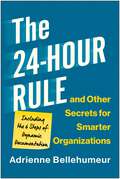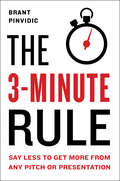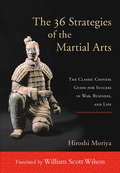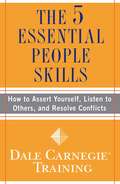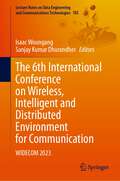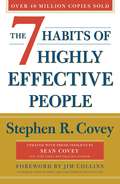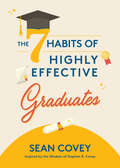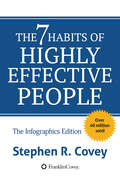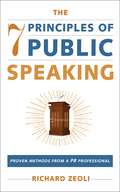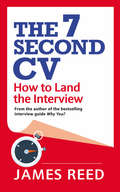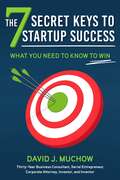- Table View
- List View
The 10th International Conference on Computer Engineering and Networks (Advances in Intelligent Systems and Computing #1274)
by Xuesong Qiu Qi Liu Xiaodong Liu Tao ShenThis book contains a collection of the papers accepted by the CENet2020 – the 10th International Conference on Computer Engineering and Networks held on October 16-18, 2020 in Xi’an, China. The topics focus but are not limited to Internet of Things and Smart Systems, Artificial Intelligence and Applications, Communication System Detection, Analysis and Application, and Medical Engineering and Information Systems. Each part can be used as an excellent reference by industry practitioners, university faculties, research fellows and undergraduates as well as graduate students who need to build a knowledge base of the most current advances and state-of-practice in the topics covered by this conference proceedings. This will enable them to produce, maintain, and manage systems with high levels of trustworthiness and complexity.
The 11 Laws of Likability: Relationship Networking. . . Because People Do Business with People They Like
by Michelle Tillis LedermanWhen establishing a relationship with someone, coming across as manipulative and self-serving is a bad move. That&’s why Michelle Tillis focuses on the power of deep and authentic connections to achieve business success.As the founder and CEO of the management training organization Executive Essentials, Michelle Tillis coaches and trains leaders to experience continual growth and achieve results through the power of collaboration, communication, and relationships.In this book, she presents activities, self-assessment quizzes, and real-life anecdotes from professional and social settings to show you how to identify what's likable in yourself and use those characteristics to build connections with other professionals.In The 11 Laws of Likability, you will discover:how to start conversations and keep them going with ease;convert acquaintances into friends;uncover people's preferences;tweak your personal style to enable engaging, reciprocal interactions;and leave a lasting impression on others after your initial meeting.We all know that networking is important, and that forming relationships with others is a vital part of success. However, traditional forms of networking often remove emotions from the equation--focusing only on immediate goals.The 11 Laws of Likability teaches you how to build the kind of deep relationships that have true staying power, bring genuine joy, and provide long-term support.
The 11 Myths of Media Violence
by Dr W. James PotterThe 11 Myths of Media Violence clearly explains why media violence has not only been allowed but encouraged to escalate. Esteemed author W. James Potter challenges many of our assumptions about the relationship between media and violence. He argues that these assumptions are the primary barriers preventing us from confronting the issue of violence in films, TV, and video games. Students and scholars of Mass Media, Communications, Film, and Sociology will find The 11 Myths of Media Violence inspires passionate discussion and innovative research. Consumer activists, teachers, and families will find it an essential resource and invaluable step toward finding solutions to this critical social issue.
The 12 Week Year for Writers: A Comprehensive Guide to Getting Your Writing Done
by Brian P. Moran Michael Lennington A. Trevor ThrallGet more words on the page with this proven and popular system The 12 Week Year for Writers: A Comprehensive Guide to Getting Your Writing Done is an easy-to-implement and practical framework for writers to get more work done in less time. You’ll answer big picture questions—What is my vision for the future? What are my writing goals?—while enacting a comprehensive system to plan and execute your writing. You’ll create a 12 Week Plan and a Model Week, collaborate with a weekly writing group, keep score, and learn to stick to a weekly execution routine. The book will also show you how to: Manage multiple writing projects at the same time Develop a prolific writer’s mindset and increase your output with the 12 Week Year system Deal with actionable specifics, like when and where to write Ideal for writers in all genres and fields, The 12 Week Year for Writers is the perfect hands-on guide for academic and business writers, authors, students, columnists, bloggers, and copy and content writers who seek to increase their productivity and get more quality words on the page.
The 18 Immutable Laws of Corporate Reputation: Creating, Protecting, and Repairing Your Most Valu
by Ronald J. AlsopA veteran Wall Street Journal editor and authority on branding, marketing and reputation provides the 18 crucial rules for companies to follow in developing and protecting their reputation, which can be their most valuable asset or their worst nightmare. A must read book for senior executives, consultants, advertising, public relations, and marketing professionals.From Enron and WorldCom to the Catholic Church and Major League Baseball, reputation crises have never been more widespread. Now Ronald J. Alsop, a veteran Wall Street Journal authority on branding and reputation management, explains the dangers—and gives organizations the eighteen crucial laws to follow in developing and protecting their reputations. Consider this example of a simple decision made by a low-ranking employee: When rescue workers at the site of the World Trade Center disaster sought bottled water from a nearby Starbucks outlet, they complained that an employee charged them for it. In a matter of hours, the Internet had picked up the story and Starbucks' carefully cultivated worldwide reputation was quickly besmirched. This is just one instance among many of how the business world, ever more global and competitive, has become increasingly difficult to navigate. Studies have demonstrated the powerful impact of reputation on profits and stock prices, and yet less than half of all companies have a formal system for measuring reputation. Clearly, companies in every industry—from Dow Chemical to Disney to DaimlerChrystler—have much more to learn. It is still the rare company that realizes the full value of its reputation: how corporate reputation can enhance business in good times, become a protective halo in turbulent times, and be destroyed in an instant by people at the lowest or highest levels of the corporate ladder. Mr. Alsop provides eighteen thoroughly documented lessons based on years of experience covering every aspect of corporate reputation, with a clear distillation of the complex principles at the heart of a reputation. He explains: • How to protect your reputation when the inevitable crisis hits • How to cope with the many hazards in cyberspace • How to create a reputation for vision and industry leadership • How to establish a culture of ethical behavior • How to measure and monitor your ever-changing public image • How to make employees your reputation champions • How to decide when it's time to change your name The result is a book that is important not only for business executives, consultants, and advertising, public relations, and marketing professionals but also for anyone eager to learn more about the companies they work for, buy from, and invest in.
The 1st International Conference on Maritime Education and Development: ICMED
by Stojče Dimov Ilčev Sanja BaukThis book presents the proceedings of the 1st International Conference on Maritime Education and Development. The conference exchanges knowledge, experiences and ideas in the domain of maritime education and development, with the ultimate goal of generating new knowledge and implementing smart strategies and actions. Topics include the 4th Industrial Revolution (4IR); unmanned air/sea surface/underwater vehicles (UxV); the digital divide and Internet accessibility; digital infrastructure; IMO E-navigation strategy; smart-ship concept; automation and digitalization; cyber security; and maritime future. This proceedings pertains to researchers, academics, students, and professionals in the realm of maritime education and development.
The 2,548 Best Things Anybody Ever Said
by Robert ByrneDrawing from diverse personages from Goethe to Churchill to Woody Allen, The 2,548 Best Things Anybody Ever Said is a witty wise quotation collection that deserves a special place on every humor lover's bookshelf. These unique, funny, and outrageous quotations, previously published in four separate volumes, are now gathered together in a seemingly limitless trove of pithy and often irreverent one-liners, retorts, put-downs, jokes, and last words that cover every conceivable subject and will appeal to every taste. Highlights include: —W. C. Fields: "Start every day with a smile and get it over with." —George Burns:&” "Happiness is having a large loving family in another city." And many more.
The 2,548 Wittiest Things Anybody Ever Said
by Robert ByrneA fresh selection of sharp, witty zingers gathered from both famous and utterly unknown (but very quotable) sources, by the editor of the popular The 2,548 Best Things Anybody Ever Said Robert Byrne's quote books are widely praised as authoritative and accessible sources of sayings for any and all occasions. Byrne's own wit, diligent research, and creativity combine to form a fresh go-to reference that serves readers better than Google--no Wi-Fi required. The 2,548 Wittiest Things Anybody Ever Said is an all-new collection of clever quips and laugh-out-loud punch lines from Gracie Allen to Frank Zappa, on such topics as sex, divorce, religion, fashion, animals, and money: STEVE MARTIN: "I'd do anything for a good body except exercise and eat right." JON STEWART: "War is God's way of teaching Americans geography." NORA EPHRON: "Successful parents have adult children who can pay for their own psychoanalysis." This compilation, to be enjoyed by generations young and old, deserves a place of honor on every language lover's bookshelf.
The 2-Hour Job Search, Second Edition: Using Technology to Get the Right Job Faster
by Steve DaltonUse the latest technology to target potential employers and secure the first interview--no matter your experience, education, or network--with these revised and updated tools and recommendations.&“The most practical, stress-free guide ever written for finding a white-collar job.&”—Dan Heath, coauthor of Switch and Made to Stick Technology has changed not only the way we do business, but also the way we look for work. The 2-Hour Job Search rejects laundry lists of conventional wisdom in favor of a streamlined job search approach that produces results quickly and efficiently. In three steps, creator Steve Dalton shows you how to select, prioritize, and make contact with potential employers so you can land that critical first interview.In this revised second edition, you'll find updated advice on how to efficiently surf online job postings, how to reach out to contacts at your dream workplace and when to follow up, and advice on using LinkedIn, Indeed, and Google to your best advantage. Dalton incorporates ideas from leading thinkers in behavioral economics, psychology, and game theory, as well as success stories from readers of the first edition.The 2-Hour Job Search method has proven so successful that it has been shared at schools across the globe and is a formal part of the curriculum for all first-year MBAs at Duke University. With this book, you'll learn how to make it work for you too.
The 2-Hour Job Search: Using Technology to Get the Right Job Faster
by Steve DaltonA job-search manual that gives career seekers a systematic, tech-savvy formula to efficiently and effectively target potential employers and secure the essential first interview.The 2-Hour Job Search shows job-seekers how to work smarter (and faster) to secure first interviews. Through a prescriptive approach, Dalton explains how to wade through the Internet's sea of information and create a job-search system that relies on mainstream technology such as Excel, Google, LinkedIn, and alumni databases to create a list of target employers, contact them, and then secure an interview--with only two hours of effort. Avoiding vague tips like "leverage your contacts," Dalton tells job-hunters exactly what to do and how to do it. This empowering book focuses on the critical middle phase of the job search and helps readers bring organization to what is all too often an ineffectual and frustrating process.
The 20% Doctrine: How Tinkering, Goofing Off, and Breaking the Rules at Work Drive Success in Business
by Ryan TateGawker tech-blogger and journalist Ryan Tate reveals how businesses can inspire greater creativity and productivity by giving employees the freedom to experiment and explore their passions.We're at a crossroads. Many iconic American companies have been bailed out or gone bankrupt, while others are fighting to survive ever-increasing digitization and globalization.In The 20% Doctrine, Tate examines how companies large and small can incubate valuable innovative advances by making small, specific changes to how work time is approached within their corporate cultures. The concept of “20% Time” originated at Google, but Tate takes examples from powerful businesses like Yahoo!, National Public Radio, Flickr, and the Huffington Post to demonstrate how flexibility and experimentation can revolutionize any business model.By pursuing their passion projects, employees can fuel innovation and foster new ideas. Only through a new devotion to the unhinged and the ad hoc can American businesses resume a steady pace of development and profitability.
The 2021 International Conference on Smart Technologies and Systems for Internet of Things: STSIoT2021 (Lecture Notes on Data Engineering and Communications Technologies #122)
by Weidong Liu Jun Ye Ishfaq AhmadThis book contains papers presented at the 2021 International Conference on Smart Technologies and Systems for Internet of Things, held on November 26–27, 2021, in Shanghai, China. It covers topics like distributed processing for sensor data in CPS networks, approximate reasoning and pattern recognition for CPS networks, distributed processing in mobile networking, data analytics for social media sensor data integration, data platforms for efficient integration with CPS networks, virtualized and cloud-oriented resources for data processing for CPS networks, machine learning algorithms for CPS networks, data security and privacy in CPS networks, sensor fusion algorithms, sensor signal processing, data acquisition and preprocessing technology, intelligent computing, data mining methods and algorithms, big data system solutions and tools platform, intelligent control and intelligent management, and operational situation awareness utilizing big data-driven intelligence. It caters to postgraduate students, researchers, and practitioners specializing and working in related areas.
The 2024 Presidential Campaign: A Communication Perspective
by Robert E. Denton Jr.A comprehensive communication analysis of the 2024 presidential campaign Presidential campaigns are more than elections, they are cultural touchstones that shape national identity and political discourse. The 2024 presidential campaign was a defining moment in American history, marked by political polarization and cultural turns. In The 2024 Presidential Campaign: A Communication Perspective Robert E. Denton, Jr. and a team of esteemed scholars offer an incisive look at the strategies, narratives, and media that influenced this landmark election. Examining all key areas of the 2024 election through the lens of communication, this timely volume delves into critical facets of campaign messaging, including political advertising and established news media. Discussions of recent developments such as AI-generated content and the expansion of alternative media provide a deeper understanding of how rapid technological advancement impacts both presidential campaigns and American democracy. Each chapter provides unique insights, connecting communication theory to real-world electoral phenomena. Presents in-depth analyses of televised debates, social media strategies, and advertising Explores the use of humor in computer-generated images and political cartoons Includes chapters on candidate branding and political party conventions Addresses the impact of campaign finance on electoral outcomes Offers the latest insights into digital and mediated campaign practices Provides a unique perspective on cultural and generational shifts in U.S. politics The 2024 Presidential Campaign: A Communication Perspective is essential reading for scholars and students in Political Science, Journalism, and Communication, particularly those studying presidential campaigns, media and politics, and the presidency. Ideal for upper-level undergraduate and graduate courses, it is also a valuable resource for professionals in political campaign management.
The 24-Hour Rule and Other Secrets for Smarter Organizations: Including the 6 Steps of Dynamic Documentation
by Adrienne BellehumeurHow do we change our focus from what we KNOW to what we DO with what we know? Convert your abstract ideas, plans, and proprietary knowledge into purposeful action with an innovative six-step approach proven to solve your business problems and strengthen your workflow. It&’s one thing to have a great idea—but it&’s an entirely different thing to actually bring that idea to life. Consultant Adrienne Bellehumeur&’s purposeful practices are your key to capturing our collective brains&’ bounty—and to pull the most power from even the simplest of actions. In The 24-Hour Rule and Other Secrets for Smarter Organizations, Bellehumeur draws on the fields of productivity, knowledge management, and design thinking to form what will soon become your and your team&’s greatest work superpower. At the heart of Bellehumeur&’s six-steps of Dynamic Documentation is the &“24-Hour Rule,&” a reminder that actionable items—like to-dos, deadlines, feedback, and observations—need to be written down and shared with others. Without embracing documentation—and other memorable secrets like &“The Skill Stack Solution&” and &“The Groundhog Trap,&”—our greatest plans and hoped-for solutions will easily slide into oblivion. What&’s more, Bellehumeur&’s Dynamic Documentation is a &“zen&” approach to information management, making documentation accessible, doable, and even appealing. Not only will this refreshingly simple guide equip you with an array of practical tools, it will also bring real joy to your everyday work activities.
The 3-Minute Rule: Say Less to Get More from Any Pitch or Presentation
by Brant PinvidicWant to deliver a pitch or presentation that grabs your audience’s ever-shrinking attention span? Ditch the colorful slides and catchy language. And follow one simple rule: Convey only what needs to be said, clearly and concisely, in three minutes or less. That’s the 3-Minute Rule.Hollywood producer and pitch master Brant Pinvidic has sold more than three hundred TV shows and movies, run a TV network, and helmed one of the largest production companies in the world with smash hits like The Biggest Loser and Bar Rescue. In his nearly twenty years of experience, he’s developed a simple, straightforward system that’shelped hundreds—from Fortune 100 CEOs to PTA presidents—use top-level Hollywood storytelling techniques to simplify their messages and say less to get more. Pinvidic proves that anyone can deliver a great pitch, for any idea, in any situation, so your audience not only remembers your message but can pass it on to their friends and colleagues. You’ll see how his methods work in a wide range of situations—from presenting investment opportunities in a biotech startup to pitching sponsorship deals for major sports stadiums, and more. Now it’s your turn. The 3-Minute Rule will equip you with an easy, foolproof method to boil down any idea to its essential elements and structure it for maximum impact.Simplify. Say less. Get More.
The 30-Day Love Detox: Cleanse Yourself of Bad Boys, Cheaters, and Men Who Won't Commit -- And Find A R eal Relationship
by Wendy WalshThere is no question the terrain has changed. We can do what we want and date who we want, but do we have the tools to navigate our hard-won sexual freedom? Now, from the dating doyenne of the Sex and the City generation comes a groundbreaking prescription for smart, savvy, slow-love. Dr. Wendy Walsh's outside-the-box approach to relationships turns traditional thinking on its head by using evolutionary psychology to offer advice that is both empowering and practical.In The 30-Day Love Detox, Walsh offers a step-by-step, five-part attachment strategy with a 30-day "detox" that helps weed out the bad boys and sets you up to meet the right guy, including:- The five sexual myths that keep women single- When to say yes to sex in a new relationship- How to use technology to bring your crush closer- How to spot a commitment-oriented man at his peak readinessMelding scientific research, anthropological truths, and proven techniques, The 30-Day Love Detox is a revolutionary road map to finding lasting love in a modern world.
The 36 Strategies of the Martial Arts: The Classic Chinese Guide for Success in War, Business, and Life
by William Scott Wilson Hiroshi MoriyaThe 36 Strategies of the Martial Arts is a classical collection of Chinese maxims on understanding, engaging, and defeating your enemy. The origin of the collection is unknown; however, the text is a synthesis of various military maxims, political expressions, and even folk sayings, some of which are from sources that date back 1,500 years. Professor Hiroshi Moriya, a Tokyo-based authority on Chinese culture and philosophy, supplies clear and succinct explanations of each maxim and illustrates them with examples not only from Chinese literature and history but also from events in Europe and modern business affairs. This book will resonate with anyone interested in a classic approach to psyching out an opponent and emerging victorious--in martial arts, business, sports, or politics.
The 5 Essential People Skills: How to Assert Yourself, Listen to Others, and Resolve Conflicts
by Dale Carnegie TrainingFrom one of the most trusted and bestselling brands in business training and throughout the world, The 5 Essential People Skills shows how to deliver a message to others with power and clarity, how to build loyalty and inspire creativity by demonstrating assertiveness, and how to be assertive.Put these five essential skills to work and begin your transformation! Have you ever walked away from a conversation full of doubts and insecurities? Do you feel as if you've lost a little ground after every staff meeting? Most of us are either too passive or too aggressive in our business life, and we end up never getting the support, recognition, or respect we desire. The business leaders and trainers from Dale Carnegie Training have discovered that applying appropriate assertiveness to all your interactions is the most effective approach to creating a successful career. The 5 Essential People Skills will help you be the most positively commanding, prosperous, and inspired professional you can be. You will learn how to: · Relate to the seven major personality types· Live up to your fullest potential while achieving personal success · Create a cutting-edge business environment that delivers innovation and results · Use Carnegie's powerhouse five-part template for articulate communications that grow business· Resolve any conflict or misunderstanding by applying a handful of proven principles Once you master these powerful skills, you will be well on your way to a new level of professional and personal achievement.
The 6th International Conference on Wireless, Intelligent and Distributed Environment for Communication: WIDECOM 2023 (Lecture Notes on Data Engineering and Communications Technologies #185)
by Isaac Woungang Sanjay Kumar DhurandherThis book presents the proceedings of the 6th International Conference on Wireless Intelligent and Distributed Environment for Communication (WIDECOM 2023), which took place at Brock University, St. Catharines, Ontario, Canada, October 11-13, 2023. The book addresses issues related to new dependability paradigms, design, and performance of dependable network computing and mobile systems, as well as issues related to the security of these systems. The goal of the conference is to provide a forum for researchers, students, scientists and engineers working in academia and industry to share their experiences, new ideas and research results in the above-mentioned areas.
The 7 Habits Of Highly Effective People: 30th Anniversary Edition (Covey Series)
by Stephen R. CoveyNew York Times bestseller—over 25 million copies soldThe No. 1 Most Influential Business Book of the Twentieth Century '[Thirty] years after it first appeared, the wisdom of The 7 Habits is more relevant than ever . . . exactly what we need now' Arianna Huffington Considered one of the most inspiring books ever written, The 7 Habits of Highly Effective People has guided generations of readers for the past three decades. Presidents and CEOs have kept it by their bedsides, students have underlined and studied passages from it, teachers and parents have drawn from it, and individuals of all ages and occupations have used its step-by-step pathway to adapt to change and take advantage of the opportunities that change creates. Now this thirtieth anniversary edition of the timeless classic commemorates the wisdom of the 7 habits with fresh insights from Sean Covey. They are: Habit 1: Be Proactive Habit 2: Begin with the End in Mind Habit 3: Put First Things First Habit 4: Think Win/Win Habit 5: Seek First to Understand, Then to Be Understood Habit 6: Synergise Habit 7: Sharpen the Saw With penetrating insights and practical anecdotes, Stephen R. Covey reveals a step-by-step pathway for living with fairness, integrity, honesty, and human dignity - principles that give us the security to adapt to change and the wisdom and power to take advantage of the opportunities that change creates.
The 7 Habits of Highly Effective Graduates
by Sean CoveyThe College Graduation Gift Idea That Says CongratulationsGift your graduate the timeless life-wisdom of The 7 Habits of Highly Effective People in this special edition designed to celebrate the college graduation milestone.Start them off strong with this invaluable graduation gift idea. College graduation is a major life event, and the steps taken after are crucial to setting your graduate up for success. This book helps new graduates begin this new phase of their life with positivity and momentum. It includes questions to challenge their current beliefs, and daily inspiration with quotes and powerful affirmations to lead them to a successful and fulfilling life.Develop highly effective habits.The 7 Habits of Highly Effective Graduates is based on the international bestseller (over 40 million sold), The 7 Habits of Highly Effective People by Stephen Covey. Start your college graduate off in life with timeless words of affirmation, inspiring quotes, and thought-provoking questions. Help them build and maintain good habits and stay focused and motivated.Packed with the proven keys to creating highly effective people, this book also includes:Thought-provoking questions on topics like trust and responsibilityAffirmations for success, focus, and positivityInspirational words from successful people If you enjoyed other FranklinCovey bestsellers such as The 7 Habits of Highly Effective People: Guided Journal, The 7 Habits on the Go, A Self-Guided Workbook for Highly Effective Teens, or The 6 Most Important Decisions You'll Ever Make; then you will love The 7 Habits of Highly Effective Graduates.
The 7 Habits of Highly Effective People: The Infographics Edition
by Stephen R CoveyThe infographics edition of this classic success guide presents Dr. Covey&’s timeless wisdom in visually powerful, highly readable graphics. Dr. Stephen R. Covey's The 7 Habits of Highly Effective People is one of the most inspiring and impactful books ever written. Since it was first published in 1989, it has helped tens of millions of people transform their lives for the better.Now you can learn critical lessons about the habits of successful people in an infographics format that makes it easy for you to apply Dr. Covey&’s 7 Habits.&“Dr. Covey&’s emphasis on self-renewal and his understanding that leadership and creativity require us to tap into our own physical, mental, and spiritual resources are exactly what we need now." —Arianna HuffingtonThe 7 Habits of Highly Effective People, Infographics Edition guides you through each habit step-by-step: · Habit 1: Be Proactive · Habit 2: Begin With The End In Mind · Habit 3: Put First Things First · Habit 4: Think Win-Win · Habit 5: Seek First To Understand Then Be Understood · Habit 6: Synergize · Habit 7: Sharpen The Saw
The 7 Principles of Public Speaking: Proven Methods from a PR Professional
by Richard ZeoliFrequently cited as the number one fear among A proven, gimmick-free lesson guaranteed to business executives, public speaking doesn't make anyone a better speaker and come naturally to most people. Pitching an idea, presenter. selling a product, or presenting a program doesn't have to be a stomach-clenching experience to be struggled through. It can be an opportunity to relish and a chance to shine in front of a group. Whether you are selling an idea to two colleagues in a conference room or presenting a major corporate strategy to a ballroom filled with shareholders, the key to success is a clear, confident, memorable presentation. With The 7 Principles of Public Speaking, Richard Zeoli makes the common sense, gimmick-free program he's offered to business leaders and political candidates available to everyone. Whether you are looking to position yourself as an industry expert, extend your sphere of influence, or gain the support and backing of vital constituencies, The 7 Principles of Public Speaking will give you the tools you need to achieve your goal. If you are a polished professional, it will help you hone your skills. If you are a novice communicator, it will help you overcome obstacles and convey your message with confidence, poise, and persuasiveness.
The 7 Second CV: How to Land the Interview
by James ReedWrite a killer CV and land your dream job. It takes an employer just seven seconds to save or reject a job applicant’s CV. In this book, James Reed – chairman of REED, Britain’s largest recruitment company – offers invaluable and specific advice on what employers want to see in the CVs they receive and how you can stand out from the crowd.Unlike other career development books, the honest advice presented here has been compiled from one-to-one interviews, surveys and countrywide workshops across REED’s network of recruitment consultants. This book is an accessible and enjoyable read, intensely practical and packed with pull-out quotes, layout examples and tips.Find out what future employers are looking for and take the first step to start loving Mondays again.
The 7 Secret Keys to Startup Success: What You Need to Know to Win
by David J. MuchowFinally, a new kind of business startup book—packed full of practical advice plus essential legal information you really need but don&’t get in business school or anywhere else!The 7 Secret Keys to Startup Success is the one book every entrepreneur should have. David J. Muchow, an award-winning, thirty-year serial entrepreneur and lawyer, gives you practical legal and business advice covering every aspect of entrepreneurship—and it&’s fun to read! It includes all the basics of building and growing a business—management, fundraising, marketing, intellectual property, and risk management—plus much more, like how to avoid the hidden mistakes that cause &“Startup Suicide&” and kill 80 percent of startups in the first year. There are also model legal forms and charts along with fun-to-read stories and examples. Muchow, who teaches law, business, and entrepreneurship at Georgetown University, has advised hundreds of businesses on how to succeed. The book reveals key mistakes that can kill businesses. For example, blogging about your new products can prevent getting a patent. And giving away too much equity and picking the wrong partners can be fatal. At the macro level, the book describes why the US should create a National Ecosystem to Support Startups (NESS) to increase our competitiveness, which could take startups from a concept to commercialization in just ninety days and speed up the patent process.This unique guide, which focuses on both the business and legal aspects of startups, is a must-have for every aspiring entrepreneur, small business owner, startup incubator, student, and for business and law schools. In The7 Secret Keys to Startup Success, you will learn: How to cut legal expenses and manage lawyersHow to fire employees and partners without getting suedPatent, trademark and copyright strategies and tricksHow to raise money without SEC problemsHow to avoid the financial &“Valley of Death&”What &“to do&” but also &“what not to do" to avoid &“startup suicide.&”Business books can be fun! Enjoy the many business stories, such as how Ivanka Trump was sued for trademark infringement over her Hettie Sandal design and Oprah Winfrey&’s battle to protect her intellectual property for O Magazine. At the end of each chapter are examples, inspired by Muchow&’s years as a foreign agent and federal prosecutor, which demonstrate the principles in that chapter. They&’re told by Professor Scooter Magee, the Startup Expert, as he helps startups prevent Startup Suicide and achieve success while fighting the CIA and others. Think Professor Indiana Jones in Raiders of the Lost Ark meets Bar Rescue or Silicon Valley! Enjoy Scooter&’s adventures while learning the critical real-life startup legal and business lessons that can help you be successful. In short, The 7 Secret Keys to Startup Success is a new kind of startup book—it&’s like having both an expert attorney and a consultant by your side every step of the way on your startup&’s journey to success—while enjoying the ride!
